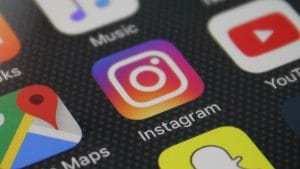Mobile devices and social media have often received a bad rap in education. They are often seen as being disruptive or distracting. This year, teachers in Geosciences have started to disrupt the disruption! Instead of banning mobile devices or becoming frustrated at eyes glued to laps, Geosciences have lured students back to the classroom and content by harnessing the distracting power of Instagram.
What is Instagram?
Since it was first launched in October 2010, Instagram has amassed over 1 billion active monthly users and is one of the most popular social networks worldwide. Instagram allows users to take photos, and now videos, on their smart phones, edit and apply exciting filters, add hashtags, and then share these online with their followers in the Instagram community.
Why use Instagram?
There is little question that social media is an important part of most students’ lives. Of all the social media platforms out there, Instagram is the one students use the most after Facebook, with 53% of adults ages 18-29 saying they use Instagram every single day.
As a social media platform, Instagram is growing faster than Twitter, Facebook, and Pinterest combined, and with more than half of users in the key university student age bracket between 18 and 29 years old. More importantly, images posted on Instagram get 23% more engagement when compared to images posted on Facebook.
Current use of Instagram in higher education
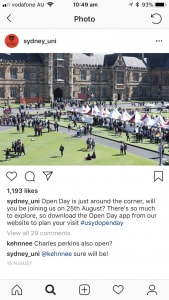
Instagram is a popular social media tool used across Universities to connect with the students and the public on a wide scale. The most common ways universities around the world are using Instagram include sharing news, achievements, and shots of daily life on campus. Engagement is largely approached from a marketing perspective, where followers are encouraged to like, share, and comment on posts made by institution accounts. At present, there little evidence either online or in the literature specifically around the use of Instagram as an educational tool to promote engaged student learning.
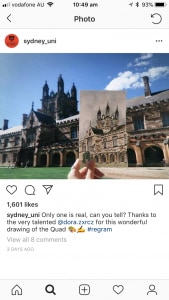
While there are an increasing number of broadly focused studies looking at using social media to engage students and support learning, or else specific investigations using the social networks Facebook or Twitter to enhance learning in higher education, research into Instagram instead tends to focus on the motivations behind Instagram use, the type of content users post to their Instagram accounts, and what usage trends might tell us about users.
The best (and only) example highlighting how Instagram can be used as a teaching and learning tool to increase student engagement comes from the UCLA library team, who are using Instagram to connect with undergraduates and engage them in teaching and learning activities beyond that of a simple marketing tool. They report that Instagram is “the most effective and rewarding” social media tool they currently use, with higher levels of meaningful engagement when compared to other networks such as Facebook or Twitter and with a demonstrated impact on student success.
Instagram & Disrupt
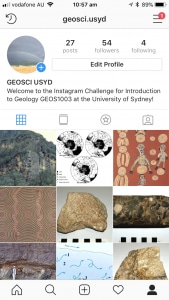
As educators, we can all point to examples where we have observed social media disrupting student learning during class, where students are distracted from what is going on by social media interactions on their phone or other devices. Though some educators have called for a ban on digital technologies in the classroom, this is incredibly hard to implement . Not only is frisking students on the door for prohibited devices undesirable (for everyone involved) but the reality is that digital technologies are here to stay: there is no putting the genie back in the bottle.
This is where we introduce “Instagram & Disrupt”. “Instagram & Disrupt” aims to turn the tables on the social media distraction and instead, disrupt the students’ world of social media. By posting images and videos of content directly related to concepts and material covered in class, we are infiltrating the social media space and harnessing Instagram’s popularity and pervasive presence in the students’ world to engage with them in their own domain.
Instagram presents an engaging and visually interesting way for students to experience course concepts and revise material in a setting they constantly inhabit, helping to strengthen their understanding of course material in an authentic way that, if done right, is connected to the course curriculum.
Added bonus: Instagram Analytics
Instagram analytics are available from both in-house and free third-party tools so you can access good reports and insights into your Instagram account. This will help you understand more about your student Instagram followers and what content they engage with (and when). Key statistics can be used to inform and refine your Instagram content and strategy. This will help you publish content your students are likely to respond to and engage with.
How it works
With a little forward planning, the “Instagram and Disrupt” method is very easy to use in any unit.
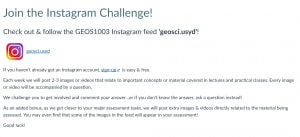
Step-by-step
- Start by setting up an Instagram account for your Unit of Study.
- e.g. GEOS1003 Introduction to Geology account: geosci.usyd
- Provide students with the account link in Canvas, ask them to sign up to Instagram (if needed!), and to follow the account.
- e.g. Sign up to the “Instagram Challenge for Introduction to Geology” here
-
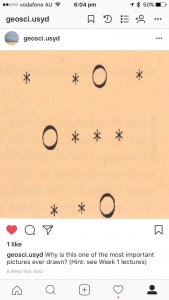
Click to enlarge Each week post 2-4 images or videos that relate to important concepts or material covered in lectures and/or practical classes. Accompany each post with a question relating to the image or video.
- Tip: try and spread your posts out over the week, rather than posting all at the same time.
- Challenge the students to get involved and comment their answers to the questions posed with each picture (or if they don’t know the answer, to ask a question instead).
- As you get closer to major assessment tasks, post a couple of extra images/videos directly related to the material being assessed (such as a rock they might have to identify or a map that might help them study).
- Tip: if possible, include some of the images you posted in the assessment – this will help incentivise engagement!
- To encourage engagement, answer any questions directly using Instagram. It also helps if you like your students’ comments in a timely manner.
Remember, you can only post to Instagram from your mobile device unless you use install some third party software.
Connecting the technology to the curriculum
While Instagram is a fun and easy way to connect with students, it is also important to make this interaction meaningful from a teaching and learning perspective. To help with this, you should consider your posts ahead of time and connect them to the learning outcomes of the unit. This is easy to do and also helps you plan ahead.
Plan Ahead!
Check out two simple examples of how you can plan ahead for your Instagram Challenge, ready for quick and seamless posting over the teaching semester.
Example Instagram & Disrupt lecture plan:
[table id=2 /]Example Instagram & Disrupt practical plan:
[table id=4 /]What worked well? What didn’t? How would we improve?
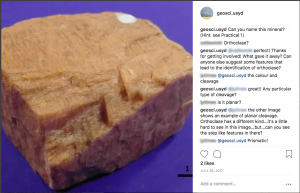
The first time we ran the Instagram Challenge was in a first year geology unit (GEOS1003) with ~100 students. We had reasonable level of engagement in the beginning, with follower numbers in the double digits, students commenting on posts, and even a few likes!
We found that our image selection were well received, related to learning outcomes and what was happening in class, and that our questions were not so hard that it prevented students from giving them a go.
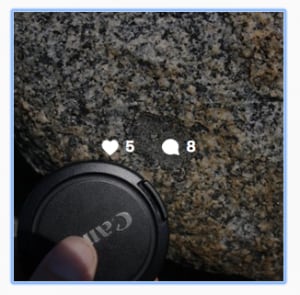
However, we definitely have room for improvement. One of the biggest stumbling blocks was a failure to plan ahead, so our posts becoming less and less frequent towards the second half of semester as the “too busy” syndrome kicked in. This really reduced student engagement even when we did post – if we couldn’t be bothered, why should they? To combat this, we will now be mapping out most of our posts before semester starts. It helps if you have all teaching academics onboard to make this go smoothly.
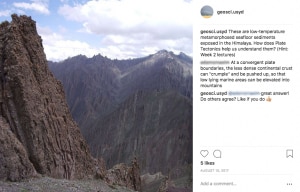
In our excitement at the beginning, we posted too many separate images at a time. This meant that students tended to pick one image to comment on while the others were ignored. Next time, we will be spreading our posts out over the week with one post 2-3 days rather than all at once.
Take home messages:
- Plan your posts ahead of semester,
- Promote the Instagram Challenge in lectures and practicals regularly,
- Respond to comments on Instagram quickly,
- Use a team account so more than one person can manage the account to spread the load,
- Post frequently but not excessively all at once – 1 key image/video 2-3 times a week would be a good place to start.
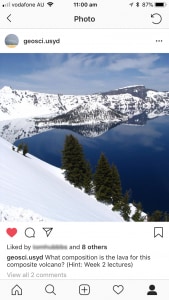
There are also plenty of articles online about how to up your game as an Instagrammer. We recommend checking a few of these out too.
In the end, we can definitely see the potential of “Instagram and Disrupt” as a teaching and learning tool. While we were not wildly successful first time around, we think this was more a result of bad planning than lack of interest. Students were genuinely engaged when we were too. By implementing the changes mentioned above we predict a much better result for round two.
Watch this space!
Many thanks to Melanie Keep, Tom Hubble, and Jessica Frawley, who contributed valuable ideas to this article.



